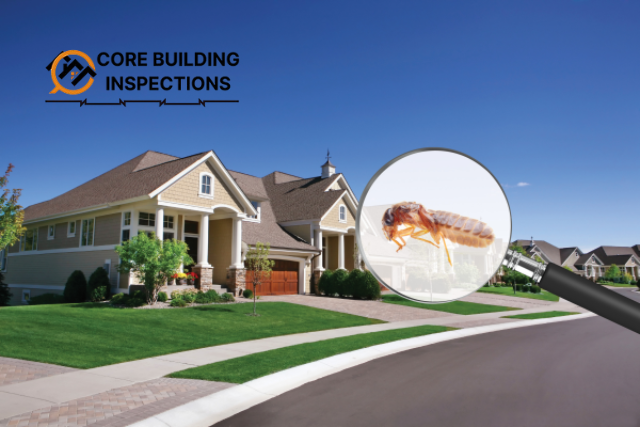Found Termites in a Pre-Purchase Inspection? What to Do Next

Pest Inspection Service 101: What to Expect During an Inspection
October 6, 2025
2025 Handover Inspection Tips for New Homes: Catch Issues Before It’s Too Late
October 19, 2025Finding termites when you’re getting a place checked out before buying it in Victoria? Yeah, that’s a real bummer. You think you’ve found the perfect house, you’re already picturing yourself living there, and then BAM! Termites. It happens a lot. But don’t freak out; it doesn’t automatically mean you can’t buy the place.
The main thing is, you did the right thing by getting it inspected by a pro. Now you know what’s up and can make a wise choice. That beats finding out later and getting stuck with a hefty bill. So, if the pest guy says there are termites, chill. Here’s what you should do next.
Step 1: Don’t Panic – Understand the Report
Your initial reaction might be alarm, but a good inspector will provide a clear, detailed report. Before you do anything, thoroughly read and understand the findings.
- Active vs. Inactive: The first thing to clarify is whether the termites are active (currently foraging and causing damage) or inactive (evidence of past activity, but no live termites found). An inactive finding suggests previous treatment or a colony has moved on, but the potential for future activity remains.
- Location and Extent: Where were the termites found? Is it a small, isolated area, or are there widespread signs of activity across multiple structural elements? The severity and location (e.g., non-structural timber vs. main support beams) are critical.
- Type of Termite: Different species of termites have different destructive potentials. Your melbourne building inspector should be able to provide this detail.
- Conducive Conditions: The report will also highlight “conducive conditions” – factors that attract termites, such as excessive moisture, timber in ground contact, or poor drainage. These need addressing regardless of active infestation.
If anything in the report is unclear, contact your inspector immediately for clarification. They are there to help you understand their findings.
Step 2: Get Expert Advice and Quotes for Treatment
Once you understand the extent of the problem, your next step is to obtain professional quotes for termite treatment and any necessary repairs.
- Pest Control Specialist: Engage a qualified and licensed pest control company (or several for comparison) to assess the situation and provide a proposal for eradication. This should include details of the treatment method (e.g., baiting, chemical barriers), the duration of the treatment, and any warranties.
- Building Repair Quotes: If structural or non-structural damage has been identified, you’ll also need quotes from a reputable builder or carpenter for repairs. Remember, fixing the damage often needs to wait until the active termites are dealt with.
- Address Conducive Conditions: Get quotes for rectifying any conducive conditions mentioned in the report (e.g., repairing leaky plumbing, improving ventilation in the subfloor, removing timber in contact with the ground). These preventative measures are crucial to deter future infestations.
These quotes will form the basis of your negotiation with the seller.
Step 3: Evaluate Your Options and Negotiate with the Seller
This is the negotiation phase. You now have solid evidence of an issue and professional estimates for its resolution.
- Request a Price Reduction: The most common approach is to negotiate a reduction in the purchase price equivalent to the cost of treatment and repairs.
- Request Seller to Treat/Repair: You could ask the seller to arrange and pay for the termite treatment and any necessary damage repairs before settlement. This option might be preferable if you want the work done by a specific company or to a certain standard, but it can extend the settlement period.
- Terminate the Contract (If Applicable): If your purchase contract includes a “pest clause” (and it absolutely should for a Pre-purchase pest inspection Victoria, you might have the right to terminate the contract if the pest issues are significant and cannot be satisfactorily resolved. This is usually a last resort but an important safeguard.
- Proceed As Is (With Caution): If the infestation is minor, or the damage is negligible, you might decide to proceed, acknowledging the issue and planning to manage it yourself after settlement. However, ensure you fully understand the implications and associated costs.
Always conduct these negotiations through your real estate agent or conveyancer, who can provide legal guidance and ensure all agreements are in writing.
Step 4: Due Diligence – Follow Up and Verify
If you proceed with the purchase and the seller agrees to treatment or repairs, it’s vital to follow up.
- Proof of Treatment: Ensure you receive official documentation from the pest control company, detailing the treatment performed, the chemicals used, and any warranties.
- Re-Inspection: Consider a follow-up Pest Inspection service (or even a combined Handover Inspection for New Home if it’s a new build that had issues) just before settlement to verify that all agreed-upon work has been completed to a satisfactory standard. This is your final check.
- Ongoing Management: Even after treatment, commit to regular annual pest inspections to monitor your property and maintain any barriers or baiting systems.
The Long-Term Perspective
Finding bugs in your house isn’t great, but it’s fixable. Good thing your bug check in Victoria did its job – saved you from a costly surprise! With the info you got, some advice, and smart talks, you can still get the house you want without worrying about termites. Scared about pests in your new house? Get Core Building Inspections to check it out and be sure your money is safe.




